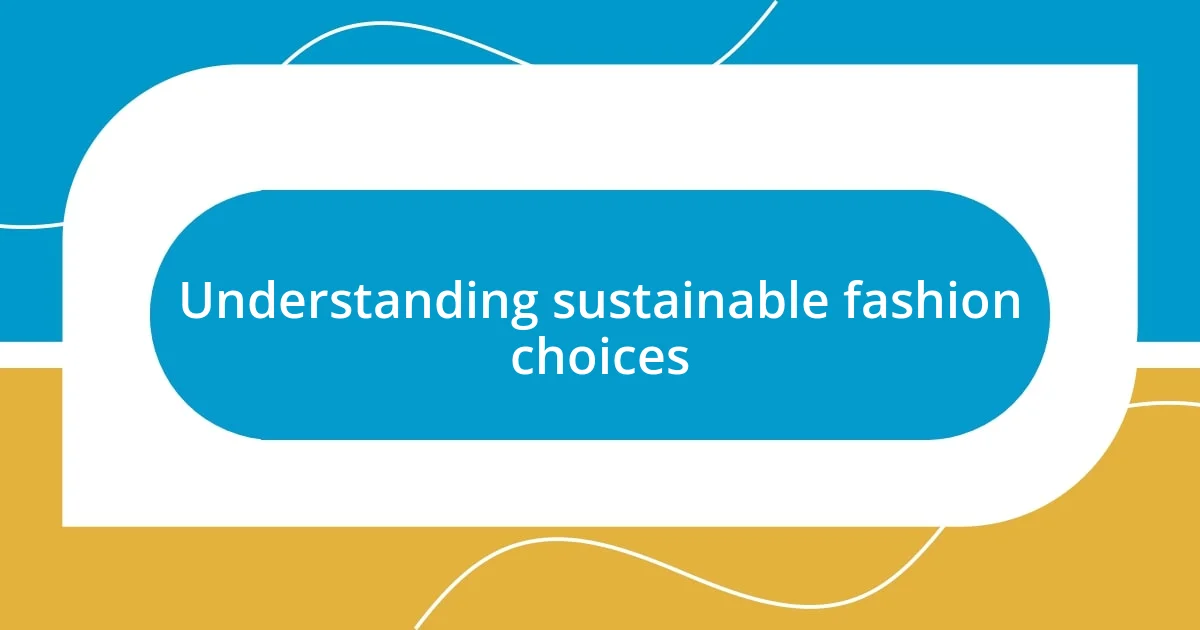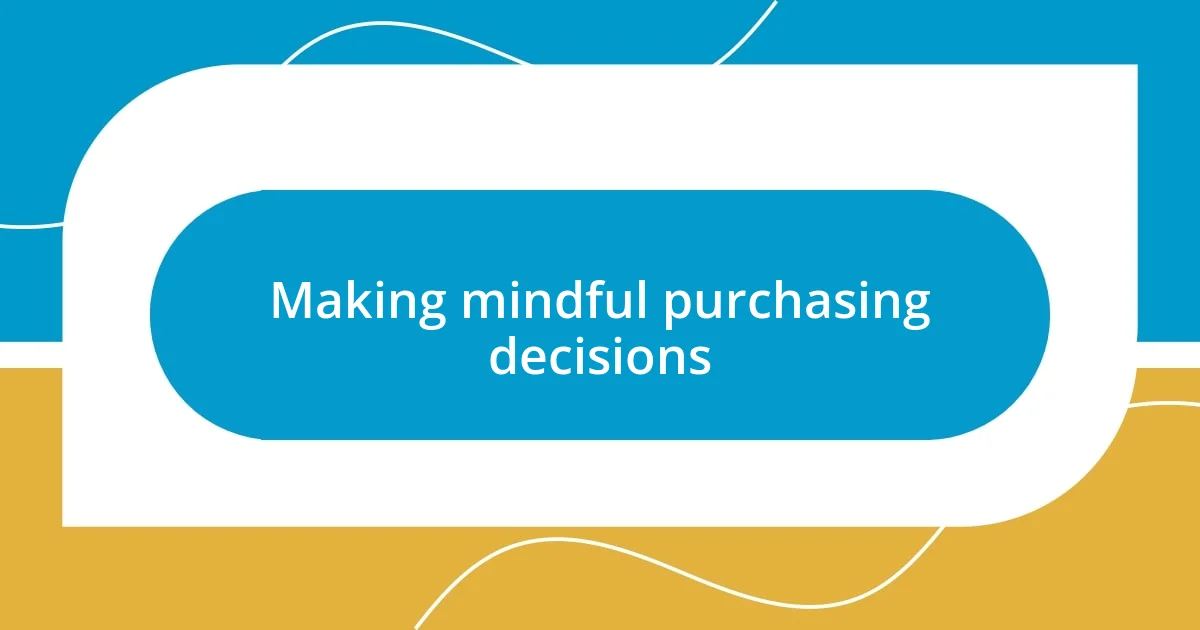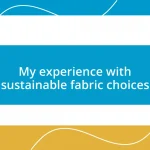Key takeaways:
- Embracing sustainable fashion empowers consumers to make eco-conscious choices through mindful shopping, supporting ethical practices, and valuing quality over quantity.
- Identifying ethical brands involves looking for transparency, certifications, and community support, which deepens the connection to clothing and enriches personal style.
- Creating a capsule wardrobe simplifies dressing, encourages creativity, and fosters a commitment to sustainability by prioritizing quality, intentionality, and reducing waste.

Understanding sustainable fashion choices
Sustainable fashion choices revolve around the idea of making more responsible and eco-conscious decisions regarding clothing. I remember my first shopping experience after deciding to embrace this lifestyle; I felt a sense of empowerment knowing that each choice I made would have a positive impact on the environment. Isn’t it fascinating how something as simple as a clothing item can contribute to environmental sustainability?
One key aspect of understanding sustainable fashion is recognizing the importance of materials. For instance, I began to pay attention to fabrics like organic cotton and Tencel, which are not only produced using fewer chemicals but also have a lighter footprint on our planet. Have you ever considered how much water and energy go into making those trendy fast-fashion pieces? This realization sparked a deeper appreciation for items that are made ethically and produced with care.
Finally, the concept of a circular economy is integral to sustainable fashion. It involves designing clothes that can be reused, repaired, or recycled. When I took the leap and started swapping clothes with friends instead of buying new ones, I felt a mix of nostalgia and excitement for the opportunities that lie in sharing my wardrobe. Isn’t it liberating to think we can enjoy fashion while reducing waste and fostering community?

Importance of sustainable fashion
Sustainable fashion is important because it directly addresses the environmental impact of the fashion industry, which is one of the most polluting sectors in the world. I remember reading about how traditional textile production often contributes to water pollution due to dyeing processes, and this realization pushed me to make mindful choices. It made me feel more connected to the clothing I wear, knowing I’m taking steps to protect our planet.
Additionally, embracing sustainable fashion promotes fair labor practices and supports local economies. I began to consciously choose brands that prioritize ethical production and fair wages. This shift not only enhanced my wardrobe but also filled me with a sense of purpose, knowing that my purchases could support artisans and workers around the globe.
Finally, I can’t overlook the impact of sustainable fashion on personal style. As I opted for timeless pieces over fleeting trends, I found more joy in curating my wardrobe. Isn’t it interesting how choosing quality over quantity can lead to a more unique and satisfying sense of style? This experience taught me that sustainable choices go beyond the environment; they also enrich our lives in unexpected ways.
| Aspect | Impact |
|---|---|
| Environmental Conservation | Reduces pollution and waste |
| Social Responsibility | Supports ethical labor practices |
| Personal Expression | Encourages unique style choices |

Identifying ethical brands
Identifying ethical brands can truly transform your shopping experience. When I first started searching for these brands, I learned to look for certifications like Fair Trade or B Corp. These labels indicate that brands prioritize ethical practices at various levels of production. I recall stumbling upon a small, local clothing brand that not only showcased beautiful, handcrafted garments but also offered transparency about their sourcing and labor practices. That kind of commitment resonated deeply with me.
To help you identify ethical brands, consider these key factors:
- Transparency: Look for brands that openly share information about their supply chain and production practices.
- Certifications: Check for recognized certifications, such as Fair Trade, GOTS (Global Organic Textile Standard), or Oeko-Tex.
- Worker Welfare: Research how brands treat their employees, ensuring they offer fair wages and good working conditions.
- Sustainable Materials: Opt for brands that use organic, recycled, or upcycled materials in their products.
- Community Impact: Seek brands that support local communities through their production processes or initiatives.
There’s a sense of joy that comes from knowing I am supporting brands that align with my values. The thrill of discovering pieces that are both stylish and ethically made gives my wardrobe a newfound depth and meaning. Isn’t it wonderful to feel that each purchase tells a story worth sharing?

Making mindful purchasing decisions
Making purchasing decisions mindfully starts with understanding the true value of what we buy. I vividly remember a time when I found myself drawn to a flashy sale only to later realize that I barely wore those impulsive buys. Now, I take a moment to reflect on whether a piece will genuinely enhance my wardrobe and fit into my lifestyle. Isn’t it liberating to let go of the pressure to constantly keep up with trends?
I also consider the longevity of my purchases. For example, I invested in a beautifully-made coat that cost a bit more upfront, but the quality has allowed me to wear it season after season. It’s surprising how much joy I find in knowing that every time I put on that coat, I’m not just making a fashion statement; I’m also affirming my commitment to sustainability. What if we all embraced this same approach?
Another key aspect is to ask myself who made my clothes. Engaging with brands that share their stories—where their materials come from and how their workers are treated—deepens my appreciation for each garment. I recall a heartfelt story from a brand that collaborates with artisans from marginalized communities, which made my purchase feel even more meaningful. It’s a small act, but when we choose thoughtfully, we can ignite a ripple effect that influences the fashion industry toward greater responsibility. How profound is it to think that our individual choices can collectively spark change?

Incorporating secondhand shopping
Incorporating secondhand shopping into my routine has been a game changer for my wardrobe and my mindset. I remember the excitement of my first thrift store visit; it felt like embarking on a treasure hunt. Each rack held endless possibilities and the thrill of unearthing unique, vintage pieces was intoxicating. Isn’t it amazing how a single item can carry stories from another time, adding depth to my personal style?
Beyond sentimental value, shopping secondhand has taught me the importance of reducing waste. One day, I found a stunning, barely-worn dress that had clearly been loved before me. Knowing that I was giving it a new life instead of letting it sit at the back of a closet resonated with me on a deeper level. It’s exhilarating to think that each secondhand purchase I make helps combat the fast fashion cycle and lessen my environmental footprint.
Additionally, secondhand shops foster a sense of community. I’ve met like-minded individuals who share their favorite finds and styling tips while browsing. This collaborative spirit reminds me that fashion isn’t just about individual expression; it’s also about connecting with others. Each time I step into a thrift shop, I’m reminded that style is personal and collective, filled with history, hope, and a commitment to sustainability. Have you ever felt that rush of excitement when discovering a piece of clothing that feels like it was made just for you?

Caring for your clothes sustainably
Caring for my clothes sustainably has become an integral part of my daily routine. I remember the first time I learned about proper washing techniques—how choosing cold water and air drying can drastically reduce energy consumption. It felt like a small gesture, yet it was empowering to realize that something as simple as my laundry habits could have a positive environmental impact. Have you ever considered how your everyday choices can shape the life of your garments?
Beyond washing, I’ve established a regular mending routine, which has truly transformed my relationship with my wardrobe. I recall a moment when I patched up a favorite pair of jeans with fabric scraps I had lying around; not only did it save the jeans, but it also added a unique flair. That experience illuminated for me how caring for clothes can become an act of creativity and self-expression. How rewarding is it to breathe new life into what may seem like discarded items?
Moreover, I’ve started organizing seasonal wardrobe checks to evaluate what I wear and what I can let go of. This practice has led me to rediscover pieces I forgot I owned. When I come across an item that no longer serves me, I ask myself if it can be repaired, repurposed, or perhaps donated to someone who’ll cherish it. It’s a refreshing process—I find peace in knowing that this cycle of care keeps my closet vibrant and reduces waste. Have you tried reassessing your collection to make way for new favorites?

Creating a capsule wardrobe
Creating a capsule wardrobe has truly streamlined my style and made getting dressed feel effortless. I vividly recall the first time I selected my core pieces—neutral tones, a couple of go-to jeans, and versatile tops. This limited selection brought clarity, and I noticed how much more I loved wearing these items because each one felt intentional. Have you ever felt lighter when you’ve simplified your choices?
I try to choose quality over quantity during this process. Investing in a few well-made pieces rather than a plethora of fast fashion items has transformed my closet. I’ll never forget the moment I bought a tailored blazer that not only fit perfectly but also made me feel empowered each time I wore it. In a way, it’s incredible how one fitting piece can boost your confidence and become a staple in your wardrobe. How many of your items can you say that about?
Ultimately, my capsule wardrobe has allowed me to embrace creativity within limitations. I’ve started pairing items I once thought had to be worn a certain way—like mixing a formal top with casual bottoms—and discovered exciting new looks. One day, I jazzed up a simple white tee with a statement necklace, and it was as if I had unearthed a hidden layer of my personal style. Have you explored how your staples can be transformed with just a hint of imagination?














